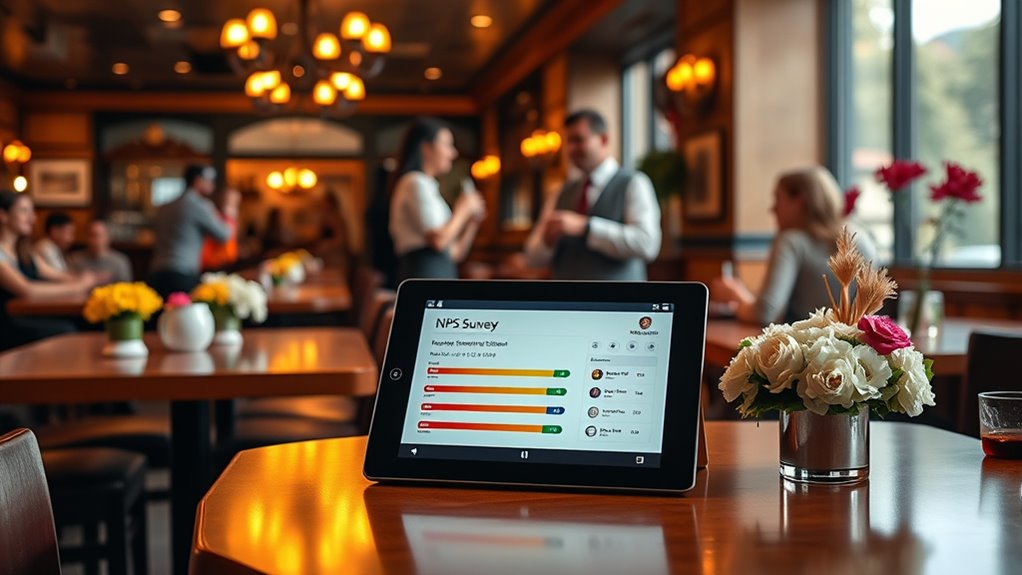Using Net Promoter Score (NPS) in your restaurant helps measure customer loyalty by asking how likely they are to recommend your place on a 0-10 scale. You can collect feedback through receipts, tablets, or emails shortly after dining. Analyze patterns to spot strengths and weaknesses, then use that feedback to improve service and training. Tracking your scores over time shows progress, and incorporating insights into your strategy keeps your restaurant growing. Learn more about optimizing NPS for your success.
Key Takeaways
- Collect NPS data shortly after dining via receipts, tablets, or emails to ensure fresh and honest customer feedback.
- Analyze NPS distribution to identify strengths, weaknesses, and urgent issues like detractors’ concerns.
- Use feedback patterns to implement targeted improvements in service, staff training, or menu offerings.
- Track NPS scores over time to measure progress, identify trends, and assess the impact of operational changes.
- Share insights with staff, set measurable goals, and communicate results to foster continuous improvement.
Understanding the Basics of NPS in the Restaurant Industry

Understanding the basics of NPS in the restaurant industry is essential for gauging customer satisfaction and loyalty. NPS measures how likely your customers are to recommend your restaurant to others, providing a clear indicator of overall satisfaction. It’s calculated by asking customers a simple question: “On a scale of 0 to 10, how likely are you to recommend us?” Responses are then categorized into promoters (9-10), passives (7-8), and detractors (0-6). Your NPS score is derived by subtracting the percentage of detractors from the percentage of promoters. This straightforward metric helps you identify strengths and areas for improvement. By understanding NPS fundamentals, you gain valuable insights into customer perceptions, enabling you to make targeted enhancements that boost loyalty and growth in your restaurant. Enriched with professional insights, understanding how to interpret NPS scores can further refine your customer service strategies.
How to Collect NPS Data From Your Customers

To effectively gather NPS data from your customers, you need to choose the right methods and timing for asking the survey question. Consider asking diners shortly after their meal when their experience is fresh in their mind. You can place a quick survey on receipts, send follow-up emails, or use tablets at tables to collect responses. Keep your questions simple—just the core NPS question: “On a scale of 0 to 10, how likely are you to recommend this restaurant to a friend?” Avoid overwhelming customers with multiple questions at once. Timing matters—capture feedback when it’s most convenient and relevant. This approach ensures you get honest, actionable insights that accurately reflect your customers’ experiences. Incorporating customer feedback from water parks and aquatic activities can also provide valuable context for your restaurant’s service quality.
Analyzing NPS Scores to Identify Strengths and Weaknesses

You can uncover your restaurant’s strengths and weaknesses by examining NPS score patterns. Look for distribution trends to spot service gaps and areas needing improvement. Identifying top performers helps you replicate success across your team. Incorporating attention during customer feedback sessions can also lead to more accurate insights.
Score Distribution Patterns
Analyzing the distribution of NPS scores reveals valuable insights into a restaurant’s strengths and weaknesses. By examining how scores are spread, you can identify patterns that highlight areas for improvement or success. Look for these key patterns:
- High concentration of promoters (9-10) suggests strong customer satisfaction.
- A large number of passives (7-8) indicates neutral experiences that could be improved to boost loyalty.
- Significant detractors (0-6) point to issues needing immediate attention.
- A skewed distribution toward promoters or detractors reveals overall customer sentiment.
Understanding these patterns helps you target specific areas—whether it’s enhancing the dining experience or addressing service gaps—to elevate overall satisfaction and grow your restaurant’s reputation. Incorporating customer feedback and analyzing score trends can further refine your improvement strategies.
Highlighting Service Gaps
By examining the distribution of NPS scores, you can pinpoint specific service gaps that may be affecting customer loyalty. Low scores often reveal areas needing improvement, such as wait times or staff friendliness. To better understand these gaps, analyze feedback by grouping scores into categories:
| Score Range | Customer Sentiment | Key Issue Identified |
|---|---|---|
| 0-6 | Detractors | Poor service quality |
| 7-8 | Passives | Inconsistent experience |
| 9-10 | Promoters | Excellent service |
For example, a high number of detractors suggests serious issues, while a lack of promoters points to opportunities for growth. Recognizing these patterns helps you target specific weaknesses and refine your service to boost loyalty. Additionally, understanding the Net Promoter Score methodology can provide deeper insights into overall customer satisfaction and advocacy.
Recognizing Top Performers
Recognizing top performers through NPS scores enables you to highlight your restaurant’s strengths and replicate successful practices. By analyzing high NPS scores, you can identify which staff members, teams, or processes excel. To do this effectively, consider these steps:
- Segment feedback based on individual employees or teams.
- Identify common factors among high scorers, such as excellent service or quick response times.
- Celebrate these successes publicly to motivate staff.
- Use insights to train others and standardize best practices.
- Incorporate feedback analysis to continuously refine your approach and identify emerging areas of excellence.
Focusing on top performers helps reinforce positive behaviors and improves overall customer experience. Recognizing excellence isn’t just about praise; it’s a strategic move to elevate your restaurant’s performance and foster a culture of continuous improvement.
Implementing Feedback to Enhance Customer Experience

To improve your customer experience, you need to gather actionable insights from feedback and use them to make targeted changes. Training your staff effectively guarantees they can implement these improvements and provide better service. Regularly monitoring progress helps you stay on track and continue refining your approach for lasting success. Incorporating customer satisfaction metrics like the Net Promoter Score can further guide your efforts and measure success over time.
Gathering Actionable Insights
Gathering actionable insights from Net Promoter Score feedback is essential for making meaningful improvements in your restaurant. To do this effectively, analyze the feedback carefully and identify recurring themes or specific issues. Focus on suggestions that can directly impact the customer experience. Here are four steps to turn feedback into action:
- Categorize responses to spot patterns and prioritize areas needing improvement.
- Quantify common concerns to understand their impact on overall satisfaction.
- Engage with your team to share insights and brainstorm solutions.
- Implement targeted changes based on feedback, then monitor results for continuous improvement. Evaluating performance metrics helps in maintaining a consistent quality of service.
Training Staff Effectively
Effective staff training is essential for turning customer feedback into meaningful improvements. When you train your team well, they can address issues promptly and deliver exceptional service. Focus on clear communication, active listening, and problem-solving skills. Reinforce positive behaviors and correct deficiencies based on NPS insights. Regular training sessions ensure staff stay aligned with customer expectations and company standards. Use the following table to understand key training focus areas:
| Training Area | Purpose |
|---|---|
| Customer Service Skills | Improve interaction quality and empathy |
| Product Knowledge | Increase confidence and accuracy |
| Feedback Handling | Turn complaints into opportunities |
| Upselling Techniques | Enhance revenue and customer experience |
| Conflict Resolution | Manage difficult situations calmly |
Additionally, incorporating training on wall organization and aesthetic presentation can enhance the overall customer experience by creating a more inviting environment.
Monitoring Progress Regularly
Regularly monitoring your progress allows you to turn customer feedback into ongoing improvements. By tracking your Net Promoter Score consistently, you can identify trends and areas needing attention. To maximize this process, focus on these key steps:
- Collect feedback weekly to detect patterns early.
- Analyze responses to find common complaints or praise.
- Share insights with your team to foster accountability.
- Implement targeted changes based on the data.
- Recognize the importance of emotional support in maintaining a positive relationship with customers, which can lead to increased loyalty.
This proactive approach ensures you stay responsive to customer needs. Regular review helps you adjust service standards, refine menu offerings, and enhance overall experience. Keeping feedback loops tight creates a culture of continuous improvement. By monitoring progress consistently, you demonstrate a commitment to customer satisfaction and build loyalty over time.
Tracking NPS Over Time to Measure Progress

Tracking your NPS over time allows you to see how customer perceptions evolve and whether your efforts to improve service are working. By regularly reviewing your scores, you can identify trends, whether upward or downward, and understand the impact of changes you implement. Use consistent intervals—monthly or quarterly—to guarantee comparability. Plotting your NPS on a timeline helps reveal patterns linked to specific initiatives, staff changes, or seasonal shifts. Comparing scores over different periods also highlights long-term progress and areas needing attention. Remember, small fluctuations are normal, but sustained improvements indicate your strategies are effective. Consistent tracking keeps you informed, enabling you to make data-driven decisions and refine your approach to enhance customer satisfaction continually.
Integrating NPS Results Into Your Restaurant’S Business Strategy

To truly benefit from your NPS results, you need to embed them into your restaurant’s strategic planning process. Start by analyzing the feedback to identify recurring themes and pain points. Then, prioritize actions that will address your customers’ most common concerns. Use these insights to set measurable goals aligned with your business objectives.
Here are four ways to integrate NPS into your strategy:
- Incorporate NPS data into your staff training programs.
- Adjust menu offerings based on customer preferences.
- Enhance service quality in areas with low scores.
- Track progress over time to evaluate the impact of changes.
Embedding NPS results guarantees your decisions are customer-focused, driving continuous improvement and loyalty.
Best Practices for Communicating NPS Findings to Your Team

Effective communication of NPS findings is essential for fostering a team that understands and values customer feedback. Start by sharing results transparently, explaining what the scores mean and why they matter. Use clear visuals like charts or graphs to highlight trends and areas for improvement. Keep discussions constructive, focusing on actionable insights rather than assigning blame. Encourage team members to ask questions and share their perspectives, fostering a culture of continuous improvement. Recognize positive feedback publicly to boost morale and motivate your staff. When addressing negative scores, frame them as opportunities for growth, and collaboratively develop solutions. Regularly update your team on progress and celebrate improvements, reinforcing the importance of customer satisfaction in your restaurant’s success.
Case Studies: Successful NPS Utilization in Restaurants

Many restaurants have transformed their customer experience by successfully leveraging Net Promoter Score insights. These case studies demonstrate how NPS can drive meaningful improvements. For example, a casual dining chain used NPS data to identify specific pain points, leading to targeted staff training and menu adjustments. This boosted their score and customer loyalty. Another restaurant improved its ambiance based on feedback, creating a more inviting atmosphere. Consider these key takeaways:
- Regularly analyze NPS trends to spot patterns.
- Act swiftly on customer feedback.
- Empower staff with insights to improve service.
- Measure results to track progress.
Frequently Asked Questions
How Often Should I Survey Customers for NPS?
You might wonder how often to survey customers for NPS. Generally, it’s best to do it regularly enough to track trends but not so often that it annoys guests. Many restaurants find collecting feedback monthly or quarterly works well. This way, you stay updated on customer satisfaction, address issues promptly, and improve service accordingly. Consistency helps you understand whether changes you implement are making a positive difference.
What Factors Most Influence NPS Scores in Restaurants?
Imagine walking into a cozy restaurant, where your experience leaves a lasting impression. The factors that most influence NPS scores include the warmth of the staff, the ambiance, food quality, and wait times. When these elements align with your expectations, you’re more likely to recommend. Conversely, neglecting details like cleanliness or friendliness can dampen your overall impression. Your feedback reflects these nuances, shaping how restaurants improve and grow.
How Can NPS Improve Staff Training and Performance?
You can improve staff training and performance by regularly analyzing NPS feedback to identify common issues and strengths. Use this data to tailor training sessions, emphasizing areas needing improvement. Encourage staff to view feedback as an opportunity for growth, and recognize high performers. By actively involving your team in understanding customer sentiments, you foster a culture of continuous improvement, ultimately boosting service quality and customer satisfaction.
Are There Industry Benchmarks for NPS Scores?
You might think industry benchmarks are hard to find, but they actually exist. While NPS scores vary across sectors, many industries aim for a score of 50 or higher, indicating strong customer loyalty. For restaurants, a score between 70-80 is excellent. Keep in mind, your target should be to improve steadily rather than hit a specific benchmark, focusing on consistent growth and customer satisfaction.
How Do Seasonal Changes Affect NPS Results?
You should consider how seasonal changes impact your NPS results because customer satisfaction can fluctuate with seasons. During peak times, your restaurant might see higher scores due to busy, lively atmospheres, while off-peak seasons might lower scores due to fewer visitors or different customer expectations. By tracking these variations, you can better understand trends, address seasonal issues, and improve overall guest experience year-round.
Conclusion
Think of your NPS journey as tending a garden—you must regularly nurture, listen, and adapt to see it flourish. By consistently gathering and acting on customer feedback, you’re planting seeds for lasting loyalty and growth. Keep your eyes on the horizon, and remember, every improvement is like a drop of water helping your restaurant bloom. Stay committed, and watch your customer relationships blossom into a vibrant, thriving oasis.









